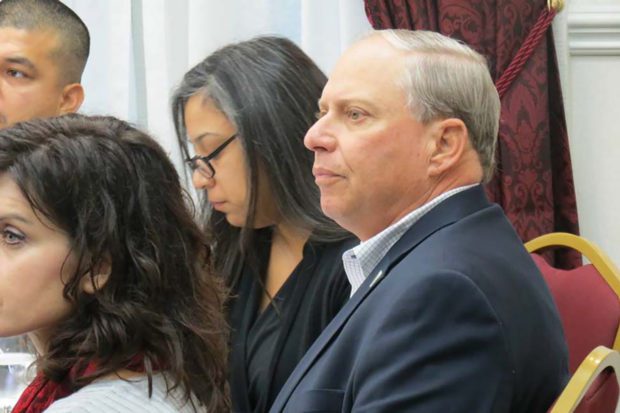
By Daniel O’Connell
As the redistricting of political districts culminates across the San Joaquin Valley, we are witnessing blatant and explicit examples of gerrymandering and systemic racism.
More than 50 years after the passage of the Voting Rights Act, the United States faces renewed attempts to limit and thwart fundamental tenets of our democratic system. As we know from history, the most determined efforts to undermine voting rights have occurred where racialized oppression was most acute and extreme—and this holds true for Fresno and the southern San Joaquin Valley.
At this strategically important moment for our region and country, we can see the threat of unfair redistricting maps as a direct assault on our collective civil rights. Over the past months, as the redistricting process has progressed, we have seen the mechanisms of bias and partisanship connect to efforts to maintain a status quo of economic inequality and racial discrimination across the region targeting underrepresented communities.
At this critical moment, then, let’s assess and analyze how these racist structures and processes of exclusion are being put into place so that we can critique, interrogate and attack them—now and in the future.
The Fresno County Board of Supervisors’ 2021 redistricting process offers a textbook study in how bias and conflicts of interest have polluted our local electoral system. Even in initiating the process, the supervisors were transparent about their intentions not to alter their current districts.
As noted in an ACLU comment letter, statements by Fresno County supervisors at their April 13 meeting openly illustrated and documented their prejudices as the redistricting process got under way:
- Supervisor Buddy Mendes offered that the 2021 redistricting process needed only “tweaking” or the “moving over” of “between three to five Census tracts.” He also referenced the previous 2011 redistricting as precedent for his position, stating that district line changes that year mostly occurred in District 5 where “the Census tract boundaries basically moved slightly to the northeast…just slightly.”
- Supervisor Nathan Magsig commented that he was saddened that his district will likely be impacted most by the 2021 redistricting process and, if he could, he would “keep the lines exactly as they are because [he] appreciate[s] the opportunity to serve everyone in [his] district.”
- Supervisor Brian Pacheco echoed the sentiment that the redistricting process would result in little change because he did not expect “wholesale changes” to the Fresno County district lines.
- And lastly, Supervisor Steve Brandau projected that the Fresno County district map would only “shift relatively slightly” because of some “broader changes based on population growth.”
These statements not only testified to the supervisors’ preferential bias for a status quo favoring their reelection but also illustrated a complete misunderstanding of changes to California state law under the Fair Maps Act.
As explained in the ACLU’s letter, “In adopting the Fair Maps Act and making traditional redistricting criteria mandatory, the California Legislature took the firm position that counties may not simply tweak lines every 10 years to address malapportionment. Instead, the line drawers must conduct a thorough process that, in the end, results in a map that keeps communities of interest together.”
New state redistricting mandates and ongoing federal requirements justify a foundational restructuring of Fresno County’s electoral districts based on massive shifts in the population of who lives here now. The 2020 Census illustrated the unequivocal demographic transformation of the county over the past three decades, especially involving its racial and ethnic composition.
Most telling, in 1990, the county’s White population was 50.7%, whereas Latinos were 35.4%. Fast forward to today, where the Census found these populations had reversed, with Whites at 27% and Latinos now 53.6% of the county’s population. Yet, have the district lines moved in any real way over all this time due to these statistics?
From the start, Fresno County’s redistricting process lacked appropriate oversight and a nonpartisan process. The hiring of National Demographics Corporation (NDC), with its questionable reputation, as the county’s redistricting consultant was a forewarning because it occurred without adequate or transparent public process by the Board of Supervisors.
But the worst violation of public trust was in the constitution of the redistricting commission itself where each supervisor selected two commissioners and the county administrative officer chose one. The commission was therefore heavily weighted by the partisan bias of the current supervisors—four out of five of whom are White men and three who are registered Republicans.
As a result, the redistricting advisory commission discounted extraordinary public input, participation and testimony from community members who proposed and favored community-driven maps that were the outcome of robust public dialogue and engagement far beyond the cursory efforts of the commission itself and, moreover, that are required by the Fair Maps Act.
One of the three commission-recommended maps—Map 101B, which had been revised just prior to the meeting at which it was recommended—wasn’t adequately agendized, could not be appropriately reviewed by the public and was inadequately analyzed even by NDC and the commission itself prior to being approved.
At the Nov. 2 Board of Supervisors hearing to consider the commission’s proposed maps, their support coalesced around Map 101B. Although this map was initially submitted from an anonymous source, a Republican political consultant and strategist later acknowledged being the map’s author, which focused on the “future growth” of suburbs (rather than centering on the existing Census data of existing communities).
While consideration of Map 101B was problematized by potential Brown Act violations, it unsurprisingly did comply with the original declarations of the Board of Supervisors for a final map with only minor changes to the existing district lines. At its subsequent meeting two weeks later, on Nov. 16, the Board of Supervisors moved forward with a slightly revised version of this map, one that is substantively unchanged from the current district lines.
The Board’s circular justification validating its choice was founded upon the recommendation of its own prejudiced commission. And a similar self-justifying logic was used in reference to their own power to make decisions related to their own elections—basically, “our own elected positions empower us to unilaterally determine if the district map choosing our own electorate is just.” An unfair system tilted to empower a White power structure found a pathway to maintain its historic unjust and racist outcomes.
California’s Fair Maps Act establishes that redistricting lines result from a thorough process that keeps communities of interest together. The law goes further to state that “communities of interest do not include relationships with political parties, incumbents or political candidates.” Aligned with the law, we know that the 2020 Census confirmed decades-long trends where the Latino population and other historically disenfranchised communities are expanding rapidly.
Correspondingly, the new district maps should be representative of these demographic changes, rather than prioritize the incumbency of current elected officials.
The most numerous and historically oppressed communities of interest must be prioritized and accentuated in the drawing of new district maps at this critical juncture point. The supervisors, however, advocated from the dais in precisely the opposite direction—prioritizing the interests and representation of affluent enclaves in the north of the city of Fresno, such as the Fig Garden and El Paseo neighborhoods, and Clovis.
During Fresno’s redistricting process, it was community-based organizations who actually engaged in an inclusive, multiracial, geographically expressive survey of the county’s residents and especially focused on underrepresented groups such as immigrants, farmworkers and lower-income neighborhoods. The outpouring of passionate, courageous commentary and community engagement, particularly by Spanish-speaking women, was juxtaposed to ugly episodes of racist intimidation and threatened violence by White thugs at commission hearings.
If the final Board of Supervisors approved redistricting map does not account for the major substantive demographic changes that have occurred in its jurisdiction and fails to incorporate the Fair Maps Act’s mandatory ranked criteria to establish its communities of interest, then it will likely be noncompliant and in possible violation of new state and existing federal laws.
The redistricting process in Fresno County and numerous other jurisdictions in the region has violated standards of fairness and impartiality. The integrity of the process and its final product have been riven and stained by conflicts of interest. As incumbents manipulate redistricting processes to retain power, they undercut our ability to elect competent, responsive and truly representative elected officials.
Voting rights are civil rights! Now is the moment to ensure that we are not fighting on uneven ground for another decade. On Dec. 4 at 11 a.m., join the March for our Future, starting at Arte Américas in a region-wide mobilization to demand fairness and democratic standards in redistricting processes across the valley and state.
*****
Daniel O’Connell, Ph.D., is the recent author of In the Struggle: Scholars and the Fight against Industrial Agribusiness in California and is director of the Central Valley Partnership.

